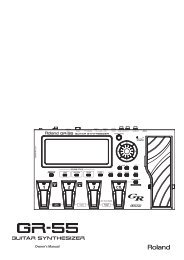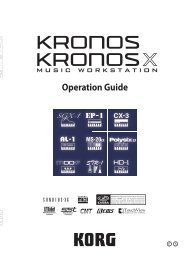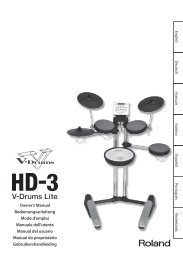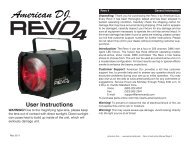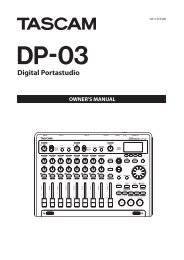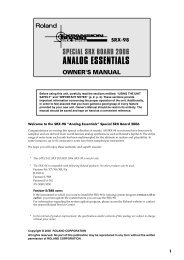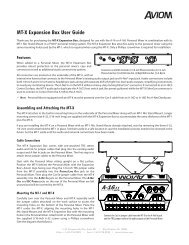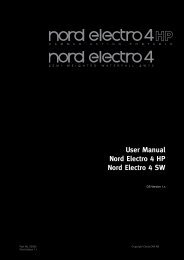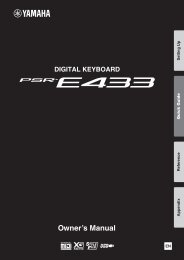Korg Microkorg Owner's Manual - zZounds.com
Korg Microkorg Owner's Manual - zZounds.com
Korg Microkorg Owner's Manual - zZounds.com
Create successful ePaper yourself
Turn your PDF publications into a flip-book with our unique Google optimized e-Paper software.
21. GLOBAL<br />
Here you can make overall settings for the microKORG. "MASTER TUNE" (knob 1) and "MASTER TRANSPOSE" (knob 2) adjust the pitch.<br />
"VELOCITY CURVE" (knob 3) specifies the velocity, "POSITION" (knob 4) specifies the MIDI IN/OUT routing, and "AUDIO IN THRU"<br />
(knob 5) specifies whether the input signal from AUDIO IN will be output directly.<br />
MASTER TUNE [30.0...50.0]<br />
Adjusts the overall pitch in 0.1 Hz<br />
steps over a range of 430.0 Hz to<br />
450.0 Hz, in terms of A4 as the reference<br />
pitch. (The highest digit "4"<br />
is not displayed.)<br />
Use this when you need to tune the<br />
pitch of the microKORG to other instruments.<br />
Figure 21-1 Figure 21-2<br />
MAX<br />
(127)<br />
Velocity<br />
(64)<br />
Curve (CrV)<br />
MIN (1)<br />
ppp Strength<br />
fff<br />
(1) (MIDI Velocity) (127)<br />
MASTER TRANSPOSE [-12...12]<br />
Adjusts the overall pitch in steps of<br />
a semitone (100 cents) over a range<br />
of one octave upward or downward.<br />
Use this when you wish to transpose<br />
to suit the song you are playing.<br />
Keyboad<br />
Figure 21-3<br />
Keyboad<br />
GLOBAL: Master Transpose<br />
FRONT PANEL: Octave<br />
GLOBAL: Velocity Curve<br />
MIDI OUT<br />
MIDI IN<br />
FRONT PANEL: Octave<br />
VELOCITY CURVE [Curve, 1...127]<br />
Selects how velocity (keyboard<br />
playing dynamics) will affect volume<br />
and tone.<br />
Use the setting that is appropriate<br />
for your situation.<br />
Curve ( ):<br />
The normal curve. (➝Figure 21-1)<br />
1...127:<br />
The fixed velocity you specify here<br />
will be output regardless of how<br />
strongly you play the keyboard.<br />
MIDI IN<br />
Arpeggiator<br />
Timbre 2<br />
Timbre 1<br />
GLOBAL: Master Transpose<br />
GLOBAL: Velocity Curve<br />
Timbre 1<br />
Arpeggiator<br />
Timbre 2<br />
MIDI OUT<br />
POSITION [Post KBD, Pre TG]<br />
Specifies the internal MIDI IN/<br />
OUT routing within the micro-<br />
KORG. This setting will affect the<br />
way in which MIDI data is transmitted<br />
and received, and how the<br />
arpeggiator data is handled.<br />
Post KBD ( ):<br />
In this position, in<strong>com</strong>ing MIDI<br />
data will be sent to the timbres<br />
without being affected by the global<br />
or front paneltranspose controls,<br />
and will not trigger the arpeggiator.<br />
Data produced by the keyboard will<br />
be converted according to the internal<br />
settings, routed through the<br />
arpeggiator (arpeggiator notes are<br />
sent as MIDI data), and then sent<br />
to the MIDI OUT connector.<br />
(➝Figure 21-2)<br />
Pre TG ( ):<br />
In<strong>com</strong>ing MIDI data will be affected<br />
by by the global settings, and will<br />
act as trigger notes for the<br />
arpeggiator. Data produced by the<br />
keyboard will be sent to the MIDI<br />
OUT connector without being (➚)<br />
AUDIO IN THRU [OFF, ON]<br />
Specifies whether the signal input<br />
from AUDIO IN will be output directly.<br />
OFF ( ):<br />
The signal will not be output.<br />
ON ( ):<br />
The signal will be output.<br />
This setting is not memorized by<br />
the Write operation. When the<br />
power is turned on, it will always<br />
be turned OFF. While you<br />
are editing, ORIGINAL VALUE<br />
will always remain lit.<br />
(➘) affected by any setting other<br />
than OCTAVE SHIFT (arpeggiator<br />
notes are NOT sent via MIDI).<br />
(➝Figure 21-3)<br />
47



